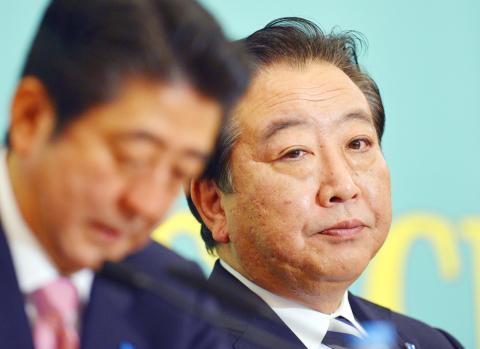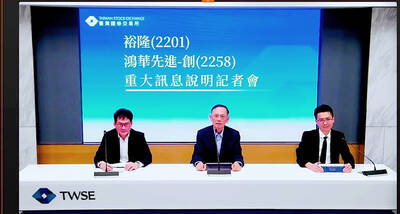Tokyo yesterday approved US$10.7 billion in fresh spending to help boost Japan’s limp economy, just weeks before an election the ruling party is expected to lose.
The ¥880 billion (US$10.7 billion) in spending was more than double a package announced in October as the country gets set for polls that are expected to usher in Japan’s seventh prime minister in six years.
However, the move, which came as official data showed Japan posted a surprise uplift in factory production in October, threatened to trigger vote-buying criticism from opposition lawmakers.

Photo: EPA
The spending will focus on boosting growth in a range of sectors, including healthcare and agriculture, as well as on public works projects following last year’s earthquake and tsunami disaster.
Opinion polls suggest Prime Minister Yoshihiko Noda and his Democratic Party of Japan (DPJ) will be defeated by the country’s main opposition leader Shinzo Abe, who heads the Liberal Democratic Party (LDP).
Abe has vowed to spend heavily on public works and pressure the Bank of Japan into launching aggressive monetary easing measures to boost growth if his party wins the Dec. 16 vote.
The central bank has unveiled two policy easing measures in recent months as its counterparts in the US and Europe launched huge moves to counter slowing growth.
Japan’s economy contracted in the July to September quarter, nudging it toward recession and dousing hopes that the nation had cemented a recovery after last year’s twin disasters, which triggered the worst atomic crisis in a generation.
Masamichi Adachi, a senior economist at JPMorgan Securities, questioned the effectiveness of the latest government stimulus measures.
“While [the package] wouldn’t be a poison, it wouldn’t be a medicine either,” Adachi told reporters.
A glimmer of hope emerged yesterday as official data showed Japan’s factory output rose 1.8 percent in October, the first rise in four months and beating market expectations of a 2.2 percent drop.
Separate figures showed the jobless rate held steady while household spending for the month was better than expected, suggesting a possible improvement in consumer confidence.
The unexpected output jump — and a producers’ survey that forecast a 7.5 output rise this month after a small decline for last month — gave the Tokyo stock market a small boost with the benchmark Nikkei 225 index adding 0.48 percent by the close.
However, the economy ministry doused hopes that the latest data was something to cheer about, saying in a statement that output was on a “downward trend.”
Credit Agricole economist Kazuhiko Ogata cautioned against optimism, saying a sustained recovery would depend on stronger overseas demand for Japanese exports, while producers will have to bring down their built-up inventory.
“A bottom-out of production would be confirmed only after the turn of the year at the earliest,” Ogata said.
Chris Tedder, research analyst at Forex.com in Sydney, said the new figures quelled “some concern of a prolonged slowdown in the world’s third-largest economy.”
However, “overall, the data isn’t enough to turn us away from predicting a recession in Japan this quarter,” he said.
As weak European markets dent demand for Japanese exports, a territorial row over islands in the East China Sea claimed by Tokyo, Taipei and Beijing has also affected the trade balance owing to a consumer boycott of Japanese brands.
Japan’s top three automakers — Toyota, Nissan and Honda — all reported that the row with China has affected sales and profits, with October data on Thursday showing a marked drop output in China, the world’s biggest vehicle market.

Taiwan Semiconductor Manufacturing Co (TSMC, 台積電) last week recorded an increase in the number of shareholders to the highest in almost eight months, despite its share price falling 3.38 percent from the previous week, Taiwan Stock Exchange data released on Saturday showed. As of Friday, TSMC had 1.88 million shareholders, the most since the week of April 25 and an increase of 31,870 from the previous week, the data showed. The number of shareholders jumped despite a drop of NT$50 (US$1.59), or 3.38 percent, in TSMC’s share price from a week earlier to NT$1,430, as investors took profits from their earlier gains

In a high-security Shenzhen laboratory, Chinese scientists have built what Washington has spent years trying to prevent: a prototype of a machine capable of producing the cutting-edge semiconductor chips that power artificial intelligence (AI), smartphones and weapons central to Western military dominance, Reuters has learned. Completed early this year and undergoing testing, the prototype fills nearly an entire factory floor. It was built by a team of former engineers from Dutch semiconductor giant ASML who reverse-engineered the company’s extreme ultraviolet lithography (EUV) machines, according to two people with knowledge of the project. EUV machines sit at the heart of a technological Cold

Taiwan’s long-term economic competitiveness will hinge not only on national champions like Taiwan Semiconductor Manufacturing Co. (TSMC, 台積電) but also on the widespread adoption of artificial intelligence (AI) and other emerging technologies, a US-based scholar has said. At a lecture in Taipei on Tuesday, Jeffrey Ding, assistant professor of political science at the George Washington University and author of "Technology and the Rise of Great Powers," argued that historical experience shows that general-purpose technologies (GPTs) — such as electricity, computers and now AI — shape long-term economic advantages through their diffusion across the broader economy. "What really matters is not who pioneers

TAIWAN VALUE CHAIN: Foxtron is to fully own Luxgen following the transaction and it plans to launch a new electric model, the Foxtron Bria, in Taiwan next year Yulon Motor Co (裕隆汽車) yesterday said that its board of directors approved the disposal of its electric vehicle (EV) unit, Luxgen Motor Co (納智捷汽車), to Foxtron Vehicle Technologies Co (鴻華先進) for NT$787.6 million (US$24.98 million). Foxtron, a half-half joint venture between Yulon affiliate Hua-Chuang Automobile Information Technical Center Co (華創車電) and Hon Hai Precision Industry Co (鴻海精密), expects to wrap up the deal in the first quarter of next year. Foxtron would fully own Luxgen following the transaction, including five car distributing companies, outlets and all employees. The deal is subject to the approval of the Fair Trade Commission, Foxtron said. “Foxtron will be